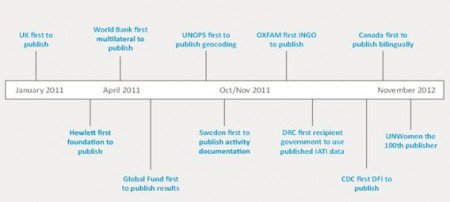Season’s greetings from IATI
In this guest blog post, IATI Delivery Manager, Kim Borrowdale, shares some of the IATI team’s highlights over the past twelve months.
In the spirit of the festive season, the IATI team considered writing a blog post on the twelve days of IATI Christmas. However, instead of pondering the IATI equivalent of ‘Pipers piping’, ‘Drummers drumming’ and the ultimate, ‘partridge in a pear tree’, we thought we’d share some of our reasons to be merry at the close of 2012.
This is by no means a full report of the many achievements and lessons learned from the past year. Stay tuned for the IATI Annual Report in March 2013 for more detail.
The leap from 15 to 100 publishers
A year ago, thirteen IATI signatories and two NGOs had published their data to IATI. This month, UN Women became the 100th organisation to publish their data to IATI. Of these, 19 are IATI signatories, and the others are implementing partners, mainly international NGOs such as Oxfam GB, CAFOD and HIVOS. A full list of IATI publishers can be found on the IATI Registry publishers’ page.
A diverse and committed membership
Since Busan, IATI’s membership has expanded from 22 signatories to 35. New members are: Belgium, Canada (CIDA), CDC, International Labour Organisation (ILO), Inter-American Development Bank (IDB), UN Capital Development Fund (UNCDF), United Nations Children’s Fund (UNICEF), UN-HABITAT, United Nations Office for the Coordination of Humanitarian Affairs (OCHA), United Nations Population Fund (UNFPA), UN Women, US Government and World Food Programme (WFP).
22 partner countries have endorsed IATI: Bangladesh, Burkina Faso, Colombia, Democratic Republic of Congo, Dominican Republic, Ghana, Honduras, Indonesia, Lebanon, Liberia, Madagascar, Malawi, Moldova, Montenegro, Nepal, Papua New Guinea, Republic of Congo, Rwanda, Sierra Leone, Syria, Tanzania, and Vietnam.
Using IATI data – compliant data at country level
Recently, IATI, with Development Gateway and Development Initiatives, has successfully piloted automated data exchange between donors’ IATI data feeds and the national aid management system in DRC, the Plateforme de Gestion de l’Aide et des Investissements (PGAI). PGAI is now using live IATI data from DFID, The Global Fund and GAVI, with plans to roll this out to other donors including Canada, EC, Netherlands, Spain, Sweden, and UNDP in the coming months. Similar work in aligning IATI data with national aid information management systems and country budgets is planned in Rwanda and Nepal, while IATI is exploring the scope for integrating data from NGOs and South-South Cooperation providers in aid management systems in Colombia.
As well as work with government partners, the aidinfo programme is working with civil society partners in Nepal, Kenya and Uganda to improve access and support use of the data being published.
IATI access and use of data
It is important to note that it is still very early days for IATI implementation, and as we have seen in other open data initiatives, it takes a little time for a market of tools to emerge. However we are starting to see the ecosystem of use of the data emerge. A number of donors (Netherlands, UK, UN Habitat, UNOPS) have built website applications to visualise their own data, and we are starting to see early versions of some interesting tools that bring all the IATI data together in one place such as AidView.net and OpenAid. These and other tools are showcased by aidinfolabs.org, which promotes new initiatives and provides access to the technical code so it can be reused. It currently has over 20 packages of code.
However, there is much to do in order to improve the accessibility of data, which highlights several development needs for IATI in 2013. The most significant is development of the IATI Registry and Data Store to enable easier access to the data. Work is being done in partnership with the Open Knowledge Foundation to provide download of a bespoke extract of data (e.g. all health projects in Ghana) in a format selected by the user.
Working toward a common standard
The IATI Secretariat convened a group to define the common standard together with representatives of IATI’s multi-stakeholder Steering Committee with representatives of the OECD DAC’s Working Party on Statistics and the leaders of the Busan Building Block on Transparency. Detailed negotiations led to an agreement that was endorsed by the final meeting of the Working Party on Aid Effectiveness (WP-EFF) in June 2012.
This confirmed that the common standard should work to combine three complementary systems, the DAC Creditor Reporting System (CRS) and Forward Spending Survey (FSS) and IATI. The group has since agreed the common template for an implementation schedule for the common standard.
What was your stand out IATI moment for 2012?
Share your stories by emailing me at [email protected] or share them with the community on Twitter by using #IATI.
